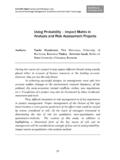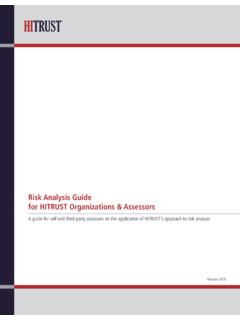Transcription of Perform Qualitative Risk Analysis - RMstudy
1 Perform Qualitative Risk Analysis 2012 Page 1 of 12 Introduction Risk Analysis can be categorised into two broad methods. They are Qualitative and quantitative in nature. Purpose and Objective The Perform Qualitative Risk Analysis process assesses and evaluates the characteristics of individually identified project risks and prioritizes risks based on agreed-upon characteristics. Evaluates probability and impact of individual risk on the project objectives. risks are categorized according to their sources or causes. Identifies areas of greater risk exposure ( , project completion date, budget, deliverable s scope) and facilitates risk responses.
2 Methods of Qualitative risk Analysis are applied to the list of positive and negative risks created or updated by the Identify risks Process. Quantitative Risk Analysis helps to determine the overall risks to project objectives resulting from the potential interactions and combined effect of all risks . Risk responses are more effective while addressing root cause (several risks originating from a common source). Critical Success Factors for Perform Qualitative Risk Analysis Process Critical success factors are: o Use Agreed-Upon Approach o Use Agreed-Upon Definitions of Risk Terms o Collect High-Quality Information about risks , and o Perform Iterative Risk Analysis Several factors leading to successful Qualitative risk Analysis are summarized in Figure 6-1.
3 Figure 6-1 Building Risk Analysis Credibility Perform Qualitative Risk Analysis 2012 Page 2 of 12 1. Agreed-Upon Approach: Agreement of the project stakeholders is a fundamental criterion and a common theme. High-quality information collected contributes to the reliability and credibility of process outputs. This approach is the foundation of process credibility. Probability of occurrence, impact on individual objectives, urgency (proximity), and manageability are the risk assessment factors.
4 O Urgency: risks requiring near term responses may be considered more urgent to address. Indicators of urgency are as follows: Lead time required for the execution of risk response Clarity of symptoms, and Warning signs triggering risk response (detectability) o Manageability: Some risks are unmanageable and attempting to address them is a waste of resources. So the project team may examine and decide to: Go forward and establish a contingency reserve. Stop or re-scope the project because of a high probability of unmanageable threat posed by risks and fear of missing out on opportunities.
5 Inform the customer of the risks and ask for a decision from their point of view. o Impact external to the project: The importance of a risk may be increased if it affects the enterprise beyond the project. 2. Agreed-Upon Definitions Risk assessment should be based on agreed-upon definitions of important terms, and they should be used consistently. Example: Levels of probability and impact on objectives helps to give realistic risk assessments, and facilitates communication of results between management and stakeholders. 3. Highly Quality Information It is gathered by interviews, workshops, and other means using expert judgment.
6 Individual data subject to reporting or intentional bias should be identified and remedied, or else a different and unbiased source of information should be found and used. Perform Qualitative Risk Analysis 2012 Page 3 of 12 4. Iteration Periodical Analysis of individual risks of project enhances the success of Qualitative risk Analysis . The frequency of Analysis is planned in the Plan Risk Management process, and events within the project also influence it. Tools and Techniques for the Perform Qualitative Risk Analysis Process Tools and techniques identify the risks that are important to the project s success.
7 They are as follows: o Select Risk Characteristics that define risks Importance o Collect and Analyze Data o Prioritize risks by Probability and Impact on Specific Objectives, o Prioritize risks by Probability and Impact on Overall Project o Categorize Risk Causes The tools and techniques used for assessing individual risks will identify the risks that are important to the project s success. This process is illustrated in Figure 6-2 Figure 6-2: The Perform Qualitative Risk Analysis Process Perform Qualitative Risk Analysis 2012 Page 4 of 12 1.
8 Select Risk Characteristics Helps to distinguish high level risk response from low level risk response. The criteria that make a risk important to management are agreed upon in advance and implemented in the tools used. Output includes a listing of risks in priority order or in priority groups such as high, moderate, and low. 2. Collect and Analyze Data Assessment of individual risks is based on information collected about them. Data collection, evaluation tools, including interviews, workshops, and references to databases of prior projects require management support and attention. Intention bias should be avoided while relying in expert judgment for the information.
9 3. Prioritize risks by Probability and Impact on Specific Objectives Helps to distinguish a risk s priority in terms of probability and impact on project objectives. It is useful since it is common to have uneven impacts on various project objectives. 4. Prioritize risks by Probability and Impact on Overall Project The reason behind constructing a measure of a specific risk s response is to ease communication with management and other stakeholders. The organization should be explicit about the single risk prioritization index, if needed, which reflects the establishment s preference among objectives.
10 It should be documented in the Plan Risk Management process. 5. Categorize Risk Causes Brings improvement in Analysis of the probability and magnitude of project risk and effective responses. Identifying common root causes of a group of risks reveal both the magnitude of the risk event and effective strategies that might address several risks simultaneously. Better understanding of the chain of risks lead to the implementation of risk for the project. It provides a realistic picture of problems of risk mitigation using scarce resources. Perform Qualitative Risk Analysis 2012 Page 5 of 12 Combined results of the Perform Qualitative Risk Analysis and risk breakdown structure shows clusters of priority risks arising from specific sources and high risk areas.




